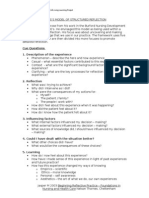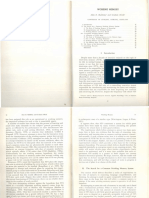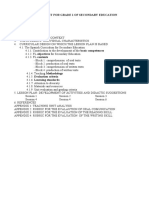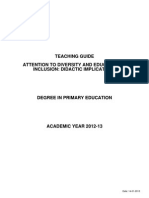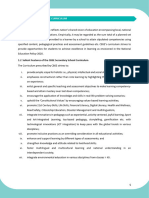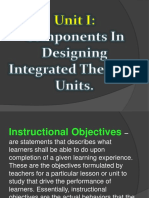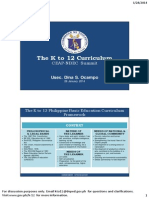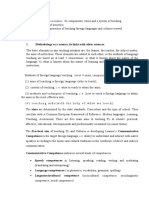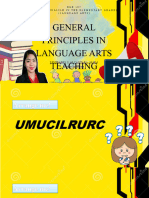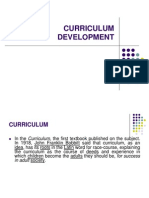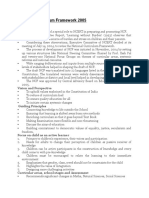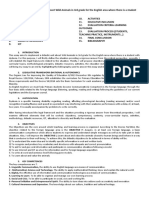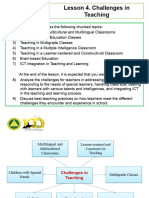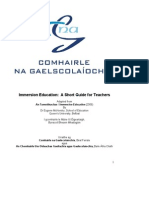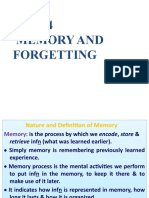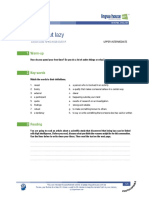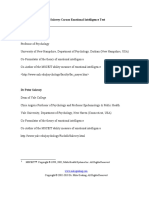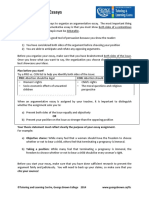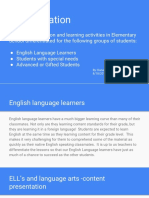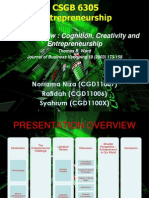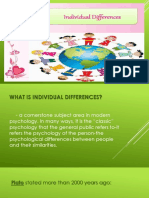Makabayan Reviewer
Makabayan Reviewer
Uploaded by
Abet BarileCopyright:
Available Formats
Makabayan Reviewer
Makabayan Reviewer
Uploaded by
Abet BarileOriginal Description:
Copyright
Available Formats
Share this document
Did you find this document useful?
Is this content inappropriate?
Copyright:
Available Formats
Makabayan Reviewer
Makabayan Reviewer
Uploaded by
Abet BarileCopyright:
Available Formats
Enhanced K to 12 Basic Education Curriculum Started 2012 to 2013 Initiated by Aquino administration Includes: universal kindergarten, 6 years in elementary,
4 years junior high school, 2 years senior high school Uplift the quality of education Meet the international standards Be prepared on emotional and cognitive aspect K to 12 covers kindergarten and 12 years of basic education to provide sufficient time for mastery of concepts and skills, develop lifelong learners, and prepare graduates for tertiary education, middle-level skills development, employment, and entrepreneurship. Salient features 1. Strengthening early child education (universal kindergarten) Alphabet, numbers, shapes and colors through games, songs and dances in their mother tongue 2. Making the curriculum relevant to learners (contextualization and enhancement) Examples, activities, songs, poems, stories, and illustrations are based on local culture, history and reality to make it relevant to learner and easy to understand Includes discussion on Disaster Risk Reduction (DRR), Climate Change Adaptation, and Information and Communication Technology (ICT) enhanced curriculum 3. Building proficiency through language (Mother Tongue-based Mutilingual Education Twelve MT languages: Bahasa Sug Bikol Cebuano Chabacano Hiligaynon Iloko Kapampangan Maguindanaoan Meranao Pangasinense Tagalog Waray English and Filipino are taught as subjects starting Grade 1 with focus on oral fluency Grade 4 to 6: gradual intro of English and Filipino as languages of instruction JHS and SHS: both are primary languages of instruction 4. Ensuring integrated and seamless learning (spiral progression) Simplest concepts to more complicated concepts Biology, Earth science, Chemistry, Geometry and Algebra are introduced to elementary students to ensure mastery of knowledge (Subjects are connected and integrated).
5. Gearing up for the future (Senior High School) Students may choose their specialization Core curriculum: languages, literature, communication, mathematics, philosophy, natural sciences and social sciences Tracks: Academic BAM (Business, Accountancy, Management); HESS (Humanities, Education, Social Sciences; STEM (Science, Technology, Engineering, Mathematics) TVET (Technical Vocational Education & Training) National Certificate Certificates of Competency 6. Nurturing the Holistically Developed Filipino (College and Livelihood st Readiness, 21 century skills) Every graduate will be equipped with: Information, media and technology skills Learning and innovation skills Effective communication skills Life and career skills Republic Act 10533 - Enhanced Basic Education Act of 2013 Approved on May 15, 2013 Signed by President Benigno S. Aquino III 2002 Basic Education Curriculum Legal Bases for Philippine Basic Education 1987 Philippine Constitution Article 14 Basic state policies on formal and non-formal education Governance of Basic Education Act of 2001 General goal of basic education: to develop the Filipino learners by providing them basic competencies, literacy and numeracy, critical thinking and learning skills, and desirable values to become caring, self reliant, productive, socially aware, patriotic, and responsible citizens. Education Act of 1982 or Batas Pambansa Blg 232 General objective of elementary, secondary, and non-formal education. Philosophy of 2002 Curriculum Ideal Filipino learner empowered for lifelong learning an active maker of meaning and can learn whatever he needs to know in any new context competent in learning how to learn and has life skills so that he becomes a self-developed person who is:
makabayan (patriotic) makatao (mindful of humanity) makakalikasan (respectful of nature) maka-Diyos (godly)
Functional Literacy the ability that is most essential for lifelong learning in our risky new world Mutual interaction: Students and Teacher Students themselves (collaborative learning) Students and Instructional Materials Students and Multi-media Sources Teacher of different disciplines (collaborative teaching) Ideal Teacher for Interactive Curriculum Not authoritarian but trustworthy facilitator or manager of learning process Enable learners to become active constructors of knowledge and not passive recipients of information Learning how is more important that learning what Values educator and serves as a role model of the learners Features of the Restructured Curriculum Functional Literacy: competence in learning how to learn throughout ones life in this changing world. Including the essential abilities such as linguistic fluency and scientific-numerical competence Basic tool subjects: English, Filipino, Science and Math Makabayan fifth learning area Laboratory of life or practice environment Most experiential, interactive, interdisciplinary, and value laden (cultural, aesthetic, athletic, vocational, politico-economic, and moral values) Demonstrates practical knowledge and life skills especially the skills of empathy, vocational efficiency and problem-solving in daily life Love of country the unifying principle for the diverse values in the fifth learning area Learning components: Sibika at Kultura/ Hekasi/ Araling Panlipunan MAPEH (Music, Arts, Physical Education, Health) EPP (Edukasyong Pantahanan at Pangkabuhayan) / THE (Technology and Home Economics GMRC/ Values Education
Integrated curriculum synonyms Thematic instruction Multidisciplinary teaching Integrated studies Interdisciplinary curriculum Interdisciplinary thematic instruction Spectrum of Integrated Curriculum 1. Traditional organization 2. Thematic teaching 3. Multidisciplinary teaching 4. Interdisciplinary teaching 5. Integrated Thematic approach Theories supporting Curriculum Integration 1. Experiential Learning Carl Rogers Facilitate learning by providing positive climate Balancing the intellectual and emotional components of learning John Dewey believes that students learn from what they experience 2. Multiple Intelligences Howard Gardner Linguistic (language smart) Logical-mathematical (number/ logic smart) Spatial (picture smart) Bodily-kinesthetic (body smart) Musical (music smart) Interpersonal (people smart) Intrapersonal (self smart) Naturalistic (nature smart) Existentialist (existence smart) 3. Constructivism knowledge is constructed from experience John Dewey, Jean Piaget, Lev Vygotsky Modes of Integrative Teaching 1. Thematic Teaching themes 2. Content-Based Instruction content learning with language teaching 3. Focusing Inquiry uses questions to organize learning 4. Generic Competency Model general competencies: personal development, social competence and work/ special skills Lesson Plan I. Objective/ Layunin competencies Taken from PELC (Philippine Elementary Learning Continuum) BEC List of Competencies II. Subject Matter/ Paksang Aralin
III.
IV.
Learning content (kinukuha sa objective) Tema e.g. Nutrisyon (core discipline) Sanggunian: pangalan ng libro at pahina Kagamitan Procedure/ Pamamaraan A. Panimulang Gawain 1. Balitaan 2. Pagsasanay 3. Balik aral B. Panlinang na Gawain 1. Pangganyak/ Motivation 2. Paglalahad 3. Pangkatang Gawain 4. Pagtalakay Questions 5. Paglalahat essential understanding C. Pangwakas na Gawain 1. Paglalapat Question from objective Pagtataya Takdang aralin
You might also like
- Johns Model of Structured ReflectionDocument1 pageJohns Model of Structured ReflectionLeeynesh Sooriyapiragasam100% (4)
- 4999EDN: The Griffith Education Internship Professional Learning PlanDocument7 pages4999EDN: The Griffith Education Internship Professional Learning Planapi-469331794No ratings yet
- Curriculum InnovationsDocument6 pagesCurriculum InnovationsSittielyka Pampangan100% (2)
- Curriculum InnovationsDocument7 pagesCurriculum InnovationsAngelo LabadorNo ratings yet
- Working Memory: Alan D. Baddeley' and Graham Hitch'Document22 pagesWorking Memory: Alan D. Baddeley' and Graham Hitch'santiago Buitrago garciaNo ratings yet
- Learning Areas in The K 12 CurriculumDocument23 pagesLearning Areas in The K 12 CurriculumRidz AmmangNo ratings yet
- Approaches To Teaching Reading:: A Philippine PerspectiveDocument86 pagesApproaches To Teaching Reading:: A Philippine PerspectiveAaron JadeNo ratings yet
- Educ 113 B ContemporaryDocument9 pagesEduc 113 B ContemporarySyrile MangudangNo ratings yet
- Sample Unit - Grade 1 Secondary Education - Components in Table Per Session - DMFDocument36 pagesSample Unit - Grade 1 Secondary Education - Components in Table Per Session - DMFAlper Aslan100% (1)
- Module5ppteduc 131009063844 Phpapp02Document92 pagesModule5ppteduc 131009063844 Phpapp02harry_123dNo ratings yet
- Language Curriulum - Module - 3Document12 pagesLanguage Curriulum - Module - 3RICHARD ALFEO ORIGINALNo ratings yet
- TTL2 (AutoRecovered)Document85 pagesTTL2 (AutoRecovered)PRINCESS JOY BUSTILLO100% (1)
- Topic 4Document2 pagesTopic 4Rebeca RodríguezNo ratings yet
- General Shaping Paper of The Matatag CurriculumDocument7 pagesGeneral Shaping Paper of The Matatag CurriculumJena VillanuevaNo ratings yet
- Marquez Maricor PED 102 Teaching Profession Module 2 Lesson 4 To 6 StudentDocument46 pagesMarquez Maricor PED 102 Teaching Profession Module 2 Lesson 4 To 6 StudentMaricorAquinoNo ratings yet
- Development and Implementation of The KBSRDocument24 pagesDevelopment and Implementation of The KBSRMike Ku100% (1)
- A Brief Note On National Curriculum Fram PDFDocument7 pagesA Brief Note On National Curriculum Fram PDFvinay sharmaNo ratings yet
- Education Process in The PhilippinesDocument12 pagesEducation Process in The PhilippinesLe@H97% (35)
- NCF 2005 and Ncfte 2009Document8 pagesNCF 2005 and Ncfte 2009AnOd80% (5)
- Teachingguide - Attention To Diversity and Educational Inclusion - Didactic ImplicationsDocument9 pagesTeachingguide - Attention To Diversity and Educational Inclusion - Didactic ImplicationsRichard Taylor PleiteNo ratings yet
- Addressing The Future: Curriculum InnovationsDocument90 pagesAddressing The Future: Curriculum InnovationsJomar M. TeofiloNo ratings yet
- K To 12 Curriculum For AllDocument42 pagesK To 12 Curriculum For AlljcruzadaNo ratings yet
- Nep 2020Document46 pagesNep 2020CHHOTE LAL SHAWNo ratings yet
- Unit 20Document10 pagesUnit 20Alejandro ChavesNo ratings yet
- A Global TeacherDocument18 pagesA Global TeacherElmor YumangNo ratings yet
- Curriculum - SrSec - 2024 25 5 6Document2 pagesCurriculum - SrSec - 2024 25 5 6Hitesh SemwalNo ratings yet
- Approaches To Teaching ReadingDocument17 pagesApproaches To Teaching ReadingMaria Rowena FloresNo ratings yet
- PED 1102 - Module 3.editedDocument8 pagesPED 1102 - Module 3.editedกาวี กบาลสักNo ratings yet
- Acosta, Raponcel A. Corpuz, Shekinah Abigail G. BSED 4-2Document47 pagesAcosta, Raponcel A. Corpuz, Shekinah Abigail G. BSED 4-2Chris DaimlerNo ratings yet
- Teaching Practice Guide For Primary School - Main PointsDocument15 pagesTeaching Practice Guide For Primary School - Main PointsClaudia MartosNo ratings yet
- Knowledge BaseDocument20 pagesKnowledge BaseMegbaru Ye Mihret LijNo ratings yet
- Qui OgueDocument21 pagesQui OgueMark TiongsonNo ratings yet
- K To 12 Curriculum For CEAP-NBEC Usec Ocampo 28 Jan 2014Document19 pagesK To 12 Curriculum For CEAP-NBEC Usec Ocampo 28 Jan 2014Mark QuiricoNo ratings yet
- Primary Education, Curriculum Development and InnovationDocument5 pagesPrimary Education, Curriculum Development and InnovationILEMUKORIT STEVENNo ratings yet
- Profed-109 - Rosario-Mark-John-Rey-R.-Module-3-ActivitiesDocument4 pagesProfed-109 - Rosario-Mark-John-Rey-R.-Module-3-ActivitiesJayacinthNo ratings yet
- Лекция 1 и 2 По Методике АнглийскогоDocument10 pagesЛекция 1 и 2 По Методике АнглийскогоHelen ProfatilovaNo ratings yet
- EGE 107 - LA - Study Guide - Unit 1.1Document36 pagesEGE 107 - LA - Study Guide - Unit 1.1its yannahhNo ratings yet
- Module 4: Becoming A Global Teacher: Educ.9 - The Teaching ProfessionDocument5 pagesModule 4: Becoming A Global Teacher: Educ.9 - The Teaching ProfessionJenerose SusonNo ratings yet
- Teaching in Multicultural and Multilingual ClassroomsDocument3 pagesTeaching in Multicultural and Multilingual ClassroomsRechelle BulawanNo ratings yet
- IV Challenges in TeachingDocument6 pagesIV Challenges in Teachingกาวี กบาลสักNo ratings yet
- Curriculum DevelopmentDocument85 pagesCurriculum DevelopmentJuliet Pillo Respeto100% (3)
- National Curriculum Framework 2005Document4 pagesNational Curriculum Framework 2005JIJIDEVI100% (1)
- K 12 and BECDocument5 pagesK 12 and BECChristian SalazarNo ratings yet
- 00000024-Supuesto 19 DyslesiaDocument6 pages00000024-Supuesto 19 DyslesiaSara AlbarranNo ratings yet
- B Week 2 - Intro To LinguisticsDocument39 pagesB Week 2 - Intro To LinguisticsBRONCANO, LERICA C.No ratings yet
- Estonia Presentation1Document27 pagesEstonia Presentation1Klang TorresNo ratings yet
- Prof Ed Group 3Document48 pagesProf Ed Group 3Jhofel BaseNo ratings yet
- Lesson 5. Challenges in TeachingDocument21 pagesLesson 5. Challenges in TeachingMarjori Anne Delos ReyesNo ratings yet
- Updates On K To 12 CurriculumDocument19 pagesUpdates On K To 12 CurriculumRamonitoElumbaringNo ratings yet
- K To 12 JTSDocument55 pagesK To 12 JTSJames FulgencioNo ratings yet
- EDUC. 6 Module 2Document7 pagesEDUC. 6 Module 2Larry VirayNo ratings yet
- Topic 3 Principles in Curriculum DesignDocument4 pagesTopic 3 Principles in Curriculum DesignLiving LegacyNo ratings yet
- 2018 - CLIL - An Introduction To Content and Language Integrated LearningDocument10 pages2018 - CLIL - An Introduction To Content and Language Integrated LearningCandy BarretoNo ratings yet
- k12 Curriculum Framework Report AlbaricoDocument29 pagesk12 Curriculum Framework Report AlbaricoJessaMae AlbaracinNo ratings yet
- Immersion Education - A Guide For Teachers PDFDocument39 pagesImmersion Education - A Guide For Teachers PDFAlejandro González Márquez100% (1)
- What Is K To 12 ProgramDocument13 pagesWhat Is K To 12 ProgramacelNo ratings yet
- Curriculum DevelopmentDocument8 pagesCurriculum DevelopmentASH BUNNo ratings yet
- PedagogyDocument8 pagesPedagogyHimaniNo ratings yet
- Basic Education Curriculum in The PhilippinesDocument5 pagesBasic Education Curriculum in The PhilippinesLiam PainNo ratings yet
- MS116 (BENLAC) MIDTERM REVIEWERDocument13 pagesMS116 (BENLAC) MIDTERM REVIEWERmaangeltheresesolayao100704No ratings yet
- Empowering Multilingual Learners: Strategies for Inclusive EdcuationFrom EverandEmpowering Multilingual Learners: Strategies for Inclusive EdcuationNo ratings yet
- Conversation Strategies and Communicative CompetenceFrom EverandConversation Strategies and Communicative CompetenceRating: 5 out of 5 stars5/5 (1)
- Sls Ukessays - Com-Skills - and - Learning - Statement - Education - Essay PDFDocument4 pagesSls Ukessays - Com-Skills - and - Learning - Statement - Education - Essay PDFKit YuenNo ratings yet
- Unit 4 Memory and ForgettingDocument18 pagesUnit 4 Memory and ForgettingTofik MohammedNo ratings yet
- The Four Idols - Francis Bacon's Philosophy On Human Understanding and Empirical InductionDocument19 pagesThe Four Idols - Francis Bacon's Philosophy On Human Understanding and Empirical InductionVictoria EliseNo ratings yet
- Research 101: Basic Concepts in Research (Chapter 3: Research Design)Document18 pagesResearch 101: Basic Concepts in Research (Chapter 3: Research Design)Jayzie OridoNo ratings yet
- Allen Ginsberg and Robert Duncan: Words and ConsciousnessDocument4 pagesAllen Ginsberg and Robert Duncan: Words and ConsciousnessparanoidpjkNo ratings yet
- Topic 6: Planning & Proposal: Action ResearchDocument15 pagesTopic 6: Planning & Proposal: Action ResearchChristine Lai XianyieNo ratings yet
- Smart But Lazy: Lingua House Lingua HouseDocument5 pagesSmart But Lazy: Lingua House Lingua Housealex8alvarez-13No ratings yet
- Individual PDPDocument4 pagesIndividual PDPvaibhav kumar KhokharNo ratings yet
- Understanding The Self Chapter 1Document6 pagesUnderstanding The Self Chapter 1LanceNo ratings yet
- MsceitDocument11 pagesMsceitadrianfmcNo ratings yet
- Argumentative Essays: Plan Before You Start! PRO: Abortion Should Be Legal CON: Abortion Should Not Be Legal Ever!Document4 pagesArgumentative Essays: Plan Before You Start! PRO: Abortion Should Be Legal CON: Abortion Should Not Be Legal Ever!Irene TeachNo ratings yet
- Al-Išārāt Wa Al-Tanbīhāt X.9 and Its Reception in The Commentary TraditionDocument12 pagesAl-Išārāt Wa Al-Tanbīhāt X.9 and Its Reception in The Commentary TraditionjawadNo ratings yet
- Thinking Fast and SlowDocument13 pagesThinking Fast and SlowRamanjeet Singh55% (11)
- Planning Where We Are in Place and Time Grade 3 4 PDFDocument4 pagesPlanning Where We Are in Place and Time Grade 3 4 PDFKunal SinghNo ratings yet
- DRP Lesson Plan 1Document3 pagesDRP Lesson Plan 1Anonymous 0Wk3epVq6No ratings yet
- Phase Theory: An IntroductionDocument239 pagesPhase Theory: An Introductiontomasgoucha100% (2)
- Differentiation For Groups of StudentsDocument11 pagesDifferentiation For Groups of Studentsapi-421042053No ratings yet
- The Educational Theory of Jean Paul SartreDocument3 pagesThe Educational Theory of Jean Paul SartreВукашин Б ВасићNo ratings yet
- Cognition Creativity and EntrepreneurshipDocument21 pagesCognition Creativity and EntrepreneurshipNorrizmaNizaNo ratings yet
- Delusion, Reality, and Intersubjectivity: A Phenomenological and Enactive AnalysisDocument21 pagesDelusion, Reality, and Intersubjectivity: A Phenomenological and Enactive AnalysisJohayra AbbasNo ratings yet
- Critical Response RubricDocument1 pageCritical Response RubricFarah Sofea RazaliNo ratings yet
- Lawson, T. (1999) - Connections and Distinctions Post Keynesianism and Critical Realism. Journal of Post Keynesian Economics, 3-14.Document14 pagesLawson, T. (1999) - Connections and Distinctions Post Keynesianism and Critical Realism. Journal of Post Keynesian Economics, 3-14.lcr89No ratings yet
- MBTI Personality Type: ESTJDocument3 pagesMBTI Personality Type: ESTJGaurang AgarwalNo ratings yet
- Individual DifferencesDocument14 pagesIndividual DifferencesKrystine Juvy Bragais100% (2)
- (Ph103) Final Oral Exam ReviewerDocument8 pages(Ph103) Final Oral Exam ReviewerdakaraNo ratings yet
- 2008 Reshaping Planning With Culture PDFDocument236 pages2008 Reshaping Planning With Culture PDFAditya Doni Agung Prasetya100% (1)
- Borges - The Other - Self As Illusion PDFDocument12 pagesBorges - The Other - Self As Illusion PDFAna Janjic100% (1)
